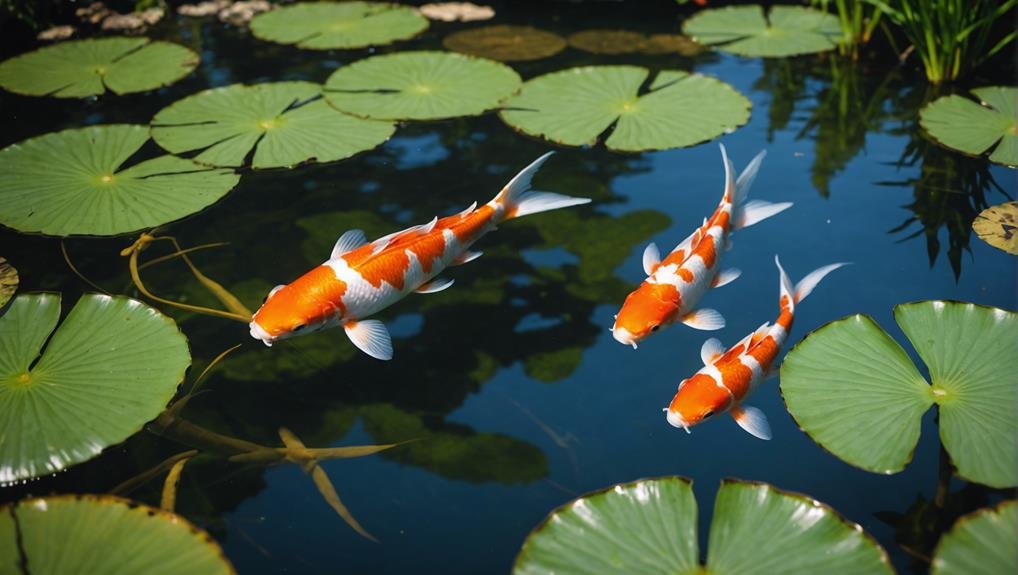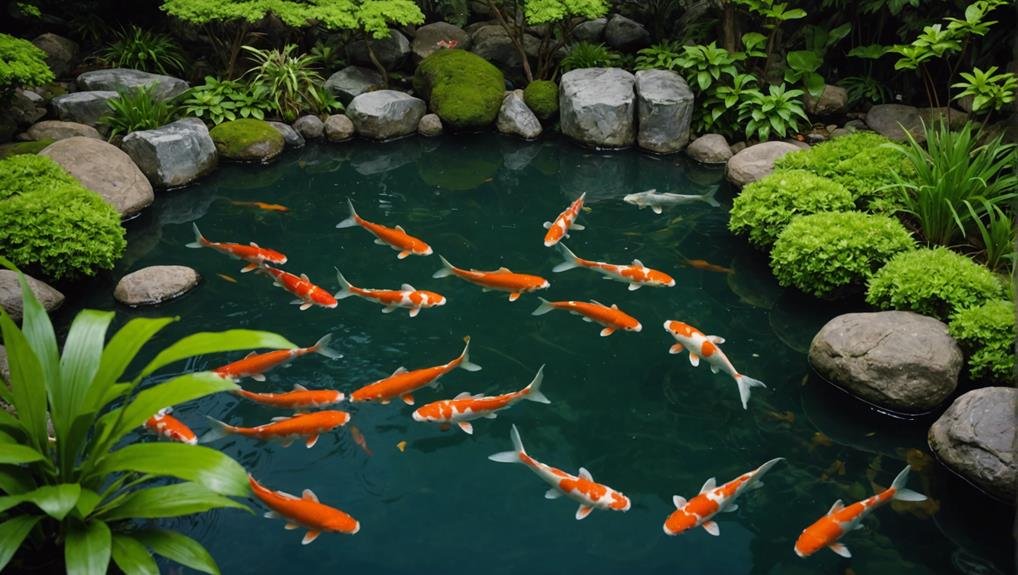Utsurimono Koi are highly prized for their bold black sumi patterns and vibrant accent colors. These beautiful fish have a long history, originating from centuries of selective breeding in China and Japan. There are three main types: Ki Utsuri (with a yellow base), Hi Utsuri (with a red or orange base), and Shiro Utsuri (with a white base). Judges evaluate these Koi based on their symmetry, the clarity and depth of their sumi patterns, and their overall health. Proper care involves maintaining top-notch water quality and providing a well-balanced diet. The unique breeding techniques used for these fish contribute to their pricing. Dive into the world of Utsurimono Koi to uncover their distinctive charm and learn about the intricacies of their care.
Origin and History
The Utsurimono Koi have a fascinating origin story, stemming from the common carp and centuries of selective breeding practices in China and Japan dating back to the 4th century. Through meticulous breeding, the Utsuri variety emerged, known for its striking black patterns and vibrant accent colors. These koi fish hold deep cultural significance in East Asia, symbolizing strength, resilience, and beauty. Initially symbols of power and wealth, they have evolved into beloved pets worldwide. The enduring appeal of Utsurimono Koi's beauty and symbolism continues to captivate enthusiasts and breeders globally, preserving a rich cultural heritage.
Varieties and Identification
To appreciate Utsurimono Koi fully, it's essential to understand the different types and their unique characteristics. These Koi stand out for their bold black sumi patterns contrasted with vibrant accent colors. One prominent variety is Ki Utsuri, distinguished by a yellow base that creates a striking contrast with the black markings. In contrast, Hi Utsuri boasts a vivid red or orange base that beautifully complements the sumi patterns. Alongside Shiro Utsuri with its white base, these varieties form the core types that enthusiasts and breeders cherish. Identifying these Koi involves noting the base color and the quality of the sumi patterns, crucial for accurate classification.
Judging Criteria

When judging Utsurimono Koi, it is essential to have a sharp eye for symmetry, health, and the unique bold sumi patterns they exhibit. Symmetry assessment involves closely examining the koi's body shape and fin alignment to ensure a well-balanced and harmonious appearance. Another crucial aspect is evaluating the distinctive sumi patterns, focusing on the depth, clarity, and crisp edges of the black markings. Judges also look for a well-distributed balance between the sumi and accent colors, particularly on the head and body of the koi. Additionally, vibrant skin quality and fluid movement are indicators of the koi's overall health. The ideal Utsurimono Koi showcases deep sumi and bold patterns, emphasizing the aesthetic presentation of these striking and reflective koi varieties.
Care and Maintenance
Taking good care of Utsurimono Koi is vital for their color vibrancy and overall well-being. Maintaining top-notch water quality is key, with parameters like temperature kept between 50°F to 78°F and a pH level of 7.5 to 8.5. It's crucial to ensure dissolved oxygen levels exceed 7 ppm and total dissolved solids fall between 75 to 100 ppm. Providing a diet rich in color enhancers and high protein content supports their vivid pigmentation. Regularly monitoring and adjusting the pond environment, including filtration and aeration, is essential for the koi to thrive. By following these guidelines, you can help preserve the health and beauty of your Utsurimono Koi.
Breeding and Pricing

Breeding Utsurimono Koi presents a unique challenge due to the complex genetic factors that influence their distinct coloration and patterns. The intricate genetic makeup and color inheritance make specialized breeding crucial for success. When breeding two Utsuri koi, Utsuri offspring are only produced 16% of the time, with Shiro Utsuri being more common due to simpler breeding processes. The pricing of Utsurimono Koi is influenced by various factors such as the costs of specialized breeding, pond size, filtration systems, and aeration.
Genetic complexity plays a significant role in breeding Utsurimono Koi, requiring breeders to carefully select and pair koi to achieve desired traits. Additionally, the inheritance of colors adds another layer of complexity, impacting the predictability of offspring patterns and hues. Specialized breeding techniques are essential to maintain the quality and beauty of Utsurimono Koi, reflecting in their pricing.
Understanding these factors is crucial for breeders looking to produce high-quality Utsurimono Koi with desirable coloration and patterns.
Conclusion
Utsurimono Koi, renowned for their striking black sumi patterns and vibrant colors, stand out as prized creations in the world of ornamental fish breeding. Their desirability is evident in the market, where exceptional specimens can fetch prices exceeding $10,000 due to their rarity and the meticulous breeding involved. These Koi are highly coveted for their unique beauty and the challenge they pose in terms of care and breeding. Their appeal lies in the strict judging standards they must meet, the specialized care they require, and the intricate breeding process. As a result, Utsurimono Koi continue to be a sought-after choice for enthusiasts looking to add elegance and sophistication to their aquatic collections.

